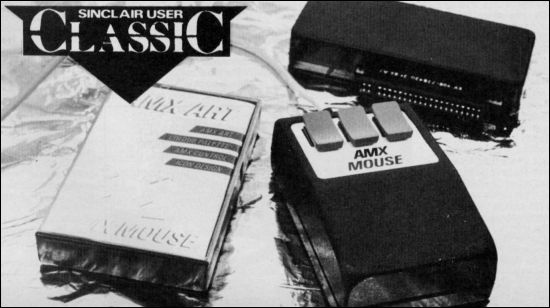| Hardware |

|
WINDOWS, icons, mice and pointers - WIMPs for short - have always struck me as just so much of a gimmick. I take it all back. The AMX Mouse from Advanced Memory Systems for the Spectrum has changed my life.
Mice are fun, easy to use, and for some things the only way to fly.
AMX has had plenty of practice in building mice. It has produced mice for the BBC and Amstrad which have become the standard. The Spectrum version looks set to become a standard too.
The package is highly professional. You get the mouse, interface-which also has a parallel printer port-and some very good software. Full marks to AMS for including a save-to-microdrive option for the software. Why can't other people do the same?
Two of the four programs come under the AMX Art banner and are as good as anything yet produced for the Spectrum - including Art Studio, which is in the process of being converted for the mouse.
You also get an AMX Control Language, a set of Basic extensions to control windows, icons, the mouse and pointers - everything you need to write your own mouse-driven programs. Lastly, there is a demo program using those extensions.
Who needs a Macintosh, ST, or Amiga when you can use the Spectrum?
|
AMX Art must be the easiest drawing program to use. On the right of the screen are a series of icons; you move the mouse to position the pointer over the one you want, press a button and then move over to the drawing window.
That window does not cover the entire screen, or even the entire drawing area-which is four times the size of a normal screen. The window can be scrolled in all four directions, using the mouse, and so some pretty impressive pictures can be built up. If you get lost there is a Showpage option which compresses the four screens into one, to give you an impression of the overall picture.
Attribute problems do not occur as AMX Art only works in black and white. Once the picture is complete it can be exported to the Colour Palette program and the colours added.
All the usual drawing facilities are available - see figure one - for lines, boxes, circles, zoom etc, plus 40 types of shading; you can also design your own. Text can be added in any position and four styles are included in the program.
When you've finished, there are various options to save part or all of the picture to tape or microdrive, or print it to the ZX printer, RS232 port on Interface 1 or the built-in port.
Colour Palette is, by comparison, fairly simple. It allows you to fill in the colours, set Bright or Flash, and save the finished picture to tape or drive.
Those drawing programs on their own would make the mouse an excellent product, but what really brings it to life are the Basic extensions to use the mouse in your own programs.
The Control program adds 28 commands to Spectrum Basic - see figure two - including windows, pull-down menus and icons as well as a very useful On Error Goto, and commands to drive the printer port. It adds two new proportional typefaces, bold and condensed.
The best example of the power of those commands is shown in the Demo program. It has a pull-down calculator and sliding block puzzle-shades of the Macintosh-which are very well done.
It could easily be adapted to form the heart of a GEM-like system and is as easily accessible from code as from Basic.
With the Control program is an Icon designer program. Naturally that is icon-driven and so very easy to use. There is space to add 32 icons to the 64 already defined-although the original 64 could be redesigned if required. As with UDG designers there are facilities to mirror in both axes, rotate and reflect, and the icon can be scrolled in all directions.
The AMX Mouse is a complete, professional package that stands amongst the best on any computer. It is certainly not cheap at £79.95, but when you consider that it is half the price of an IBM mouse (for which you then have to buy software) it is remarkable value.
John Lambert